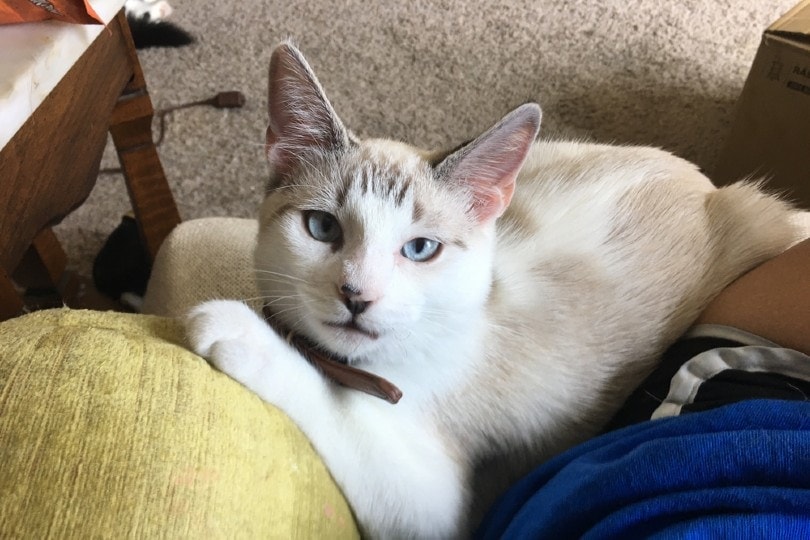Last Updated on January 14, 2025 by Pauline G. Carter
Yes, cats understand some words that humans say to them depending on context and frequency of the words. As carnivorous and territorial creatures, these feline companions are intelligent and have a fine-tuned sense of hearing, often understanding what their owners are saying to them.
Though cats may not understand all human words, they do understand the accompanying tone of voice and body language. By using consistent commands, positive reinforcement techniques, and clear body language, owners can improve their communication with their cats. Understanding the cognitive abilities of cats can enhance the human-cat relationship and promote a positive living environment for both the owner and cat.

Credit: www.hepper.com
The Science Behind Feline Communication
Do cats understand words? This is a question that many cat owners have wondered at some point. As a matter of fact, understanding feline communication is not always easy, but it is worth the effort to try. So, let’s dive into the science behind feline communication by exploring how cats use body language, vocalisations and non-vocal communication to communicate with their humans.
Understanding Cat Body Language
Have you ever wondered what your cat is trying to tell you with their body movements? Cats can convey their emotions through their body language. Try to observe your cat’s body movements and see if you can recognise any of these signs:
- Tail position: A high tail means a confident or happy cat, while a tucked-in tail represents a scared or anxious cat.
- Purring: While cats may also purr when they are happy and content, it can also be a sign of stress or pain.
- Eye contact: Direct eye contact with cats is a sign of dominance and aggression, while blinking slowly conveys trust and affection.
- Ears position: Forward ears suggest that the cat is alert and interested, while backward ears indicate fear, anger or aggression.
Recognising Different Types Of Meows
Cats use different types of meows to communicate with their humans, from long, drawn-out meows to short, sharp meows. Here are a few examples of what your cat may be trying to tell you:
- A meow combined with purring is a sign of affection, and your cat is most likely looking for attention or affection in return.
- A short, repetitive meow is a sign that your cat is probably feeling hungry, especially if it is accompanied by rubbing against your legs.
- A long, drawn-out meow is a sign that your cat is feeling lonely or bored, and it is trying to get your attention.
Understanding Vocal And Non-Vocal Communication
Cats use not only vocal, but also non-vocal communication to express their emotions. Here are a few examples of non-vocal communication that you may notice in your cat:
- Rubbing against your legs: Your cat may do this to show affection or to mark its territory.
- Kneading: A sign of affection and contentment, cats usually knead when they are feeling relaxed.
- Licking: Cats may lick themselves or their humans as a sign of affection, but it can also signify anxiety or stress.
Cats have their own language, and it takes patience and observation to understand it. By observing your cat’s body language, recognising the different types of meows and understanding their non-vocal communication, you can start communicating more effectively with your feline companion.
Factors That Affect How Cats Understand Words
When it comes to feline intelligence, the age-old debate on whether cats understand words has fascinated pet owners. While research remains inconclusive, there are several factors that may affect how cats perceive and comprehend language.
Breed Differences And Their Vocalisation Ability:
Different cat breeds possess different vocalisation abilities. Siamese cats are known for their talkative nature, while persians are typically quieter. Therefore, it may be easier for owners to communicate with a talkative cat as compared to a quiet one.
Age And Experience:
Younger cats are more inclined to learn new words. Their brains are still developing, and they can learn new words and commands quickly. Adult and senior cats can understand simple words and commands, although the process may take longer. Cats with more life experiences are better equipped to understand vocal cues and non-verbal language.
Owner-Cat Relationship:
Cats are highly intuitive animals and can pick up on their owner’s mood and vocal pitch. If an owner has a positive and healthy relationship with their cat, the feline will be more receptive to learning words and commands. A calm and personalized approach where the owner speaks in a soft voice can help the cat understand the words and contextual cues better.
Contextual Factors Such As Tone And Body Language:
Contextual factors play a significant role in how cats understand words. Cats often respond more to tone and body language than actual words. A raised tone may denote anger, while a warm and affectionate tone may indicate love and care.
Cats also pay attention to facial expressions, body posture, and hand gestures, which they interpret as non-verbal language cues.
Cats may or may not understand words, but these factors can significantly affect their ability to comprehend language. It is important for cat owners to know their cat’s breed, age, personality, and contextual cues while communicating with them. By understanding their cats better, owners can establish better relationships with them and form a better bond.
Understanding cats better is a continuous learning journey that takes patience, consistency, and love.
Do Cats Really Understand Words? A Deep Dive
As a cat owner, you’ve probably had moments where it feels like your feline companion knows exactly what you’re saying. But do cats really understand words? In this deep dive, we’ll explore the research on feline cognition and decode some of their behavior with language.
Decoding Feline Behavior With Language
When communicating with your cat, it’s essential to understand their behavior. Many feline body language and vocalizations indicate their emotions and intentions, from a gentle purr to an agitated tail flick. Here are some key points to decode feline behavior with language:
- Tone: Your tone of voice has a significant impact on your cat’s response. They are more likely to respond to a soothing tone when relaxing or playing and a firm tone when learning what they can or can’t do.
- Pitch: Cats have a higher pitch hearing than humans. When communicating with your cat through language, notice the pitch of your voice and note if your cat responds differently.
- Body language: Observe your cat’s body language to see how they respond to your communication. If they approach or run away, arch their back, or hiss, interpret them accordingly.
Research On Feline Cognition
Recent research shows that cats have an understanding of the basic physical laws and may be able to predict where objects will land based on their trajectory. Here are some key points to understand their cognitive abilities:
- Object permanence: Cats can remember an object’s existence after it disappears from sight, which is a fundamental principle of object permanence.
- Problem-solving: They have the cognitive ability to solve problems by thinking and reacting to the situation. Studies show that cats can retrieve long-term memories to solve problems.
- Memory: Cats have been shown to have a long-term memory of around 16 hours, and recent studies show that they can remember events for up to 10 years.
Cognitive Abilities Of Cats Compared To Other Animals
Cats may not have the same cognitive abilities as dogs, apes, or dolphins, but they have their unique abilities. Here’s how their cognitive abilities compare to other animals:
- Dogs: Dogs have a strong ability to sense human emotions and understand subtle human cues, making them better at social interaction than cats.
- Apes: Apes have intelligence that is similar to humans and are known to use sign language, recognize themselves in mirrors, and solve problems.
- Dolphins: Dolphins have a high level of intelligence, are highly communicative, and can perform complex tasks.
The Role Of Environment In Feline Understanding
The environment plays a crucial role in how cats understand our words. A cat that grew up in a noisy home environment may not respond the same as a cat who grew up in a quieter home. Here’s how the environment affects feline understanding:
- Background noise: Too much background noise can make it challenging for the cat to understand our words. Ensure that the settings are quiet and peaceful before trying to communicate with your feline companion.
- Training: Consistent training can help the cat understand specific phrases and actions associated with the commands. It’s essential to start training early to create a routine.
Cats have an incredible level of intuition, and though they may not understand every word we say, they can pick up on our tone, pitch, and body language to interpret our communication. Understanding your cat’s behavior and cognitive abilities can help you communicate better with your feline companion.
Frequently Asked Questions Of Do Cats Understand Words?
Do Cats Understand Human Language?
Cats don’t understand human language, but they may recognize a few phrases they associate with certain actions.
How Do Cats Communicate With Humans?
Cats often communicate with humans through body language, meows, purrs, and gestures like tail flicks.
Can Cats Recognize Their Own Names?
Cats can recognize their own names with practice and consistent reinforcement, although they may not always respond.
Can Cats Understand Emotions In Human Speech?
Cats may associate certain emotions with human speech, picking up on the tone and energy behind the words.
Do Cats Understand Non-Verbal Cues From Humans?
Cats may understand non-verbal cues from humans, such as facial expressions, body posture, and hand gestures.
Conclusion
After examining various studies and personal experiences, it is clear that cats do have an understanding of words and basic communication. While they may not comprehend complex phrases or sentences, they are able to associate certain sounds and tones with specific actions or outcomes.
It is important to note that cats also rely heavily on body language and visual cues from their owners in order to fully comprehend and respond to commands or requests. Despite their reputation for being aloof and independent, cats have a unique ability to form emotional bonds with their human companions and communicate in their own feline way.
As we continue to learn more about cats and their cognitive abilities, it is important to approach their behavior with patience, understanding, and a willingness to learn. With proper training and understanding, cats can become loving and responsive members of our families and communities.

